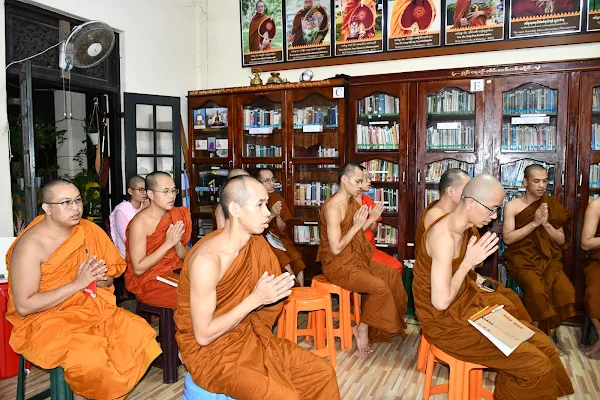Let us pay homage to the Five Infinities with joined palms, bowing with humility: Namo Buddhassa. Namo Dhammassa. Namo Sanghassa. Namo Matapitussa. Namo Acariyassa.
ဝန္ဒာမိ
19th United Nations Day of Vesak
"Three Types of Cetanā in Buddhist Practice" (စေတနာသုံးမျိုးနှင့် ဗုဒ္ဓဘာသာကျင့်စဉ်)
Did the Buddha reject these conventions? Didn't he call Ananda 'younger brother', Rahula 'son', and address others as 'dear sons and daughters'? These are conventional terms. Aren't they true for communication? But are they ultimately real? These are just conventional designations.
The five aggregates exist both in conventional and ultimate sense. How do they exist? Isn't it worth examining? They exist as impermanent (anicca), suffering (dukkha), and non-self (anatta). Are these pleasant or unpleasant qualities? They are aspects of suffering, aren't they? Isn't this worth investigating?
When you gain this understanding, consider your acts of giving. Pure intention, right? Is the intention based on concepts of people, devas, or brahmas? Does the Buddha call intention (cetana) self-view (sakkāya)? Don't the wrong views about being human, deva, or brahma fall away?
When you understand intention as a mental factor, wrong view falls away. People say 'maintain good intention, don't let intention fade' - don't they? Is intention permanent or impermanent? It's impermanent. Can you command it not to cease? It's impermanent, understand? What's important is 'don't let faith (saddhā) fade' - the confidence.
Isn't intention taught as impermanent, suffering, and non-self? Yet people say 'don't let it fade' - wouldn't that make it self (atta)? When intention is seen as impermanent, do you see intention or its non-existence? When non-existence is seen as impermanent, isn't that knowledge called Path?
Does craving arise? Does clinging arise? Does kamma arise? This is maggo-nāma-cetanā (Path intention). Isn't this worth studying? Such understanding is needed. Who directs these acts of giving? Isn't it taught as mindfulness and wisdom? This is being accompanied by mindfulness and wisdom.
When accompanied by mindfulness and wisdom, do craving and clinging still arise? Think about it. Isn't intention a mental factor? Isn't the co-arising wind element physical? These are just mind and matter. Are they persons? Don't wrong view and doubt cease when seen this way?"
For instance, with meditation retreats, don't people take responsibility for meal offerings? That initial planning, isn't it taught as pubba-cetana (prior intention)? Is it taught as 'people' or as 'intention'? The first arising is intention - pubba-cetana. Isn't this worth examining?
From pubba-cetana, you plan how to buy, prepare, and make offerings. When these plans come to fruition, doesn't it exist? At this point, isn't it taught as muñca-cetana (present intention)? Think about it.
When it's accomplished - when the cooking is done, the purchasing complete - don't you personally offer it? Isn't this taught as pubba-muñca? This is muñca-cetana.
The first arising is pubba-cetana - is it a person or intention? The second arising - is it a person or muñca-cetana? This isn't just my teaching, it's the Buddha's teaching. When the offering is complete...
Thirdly, don't you feel joy and satisfaction thinking 'my offering is successful'? Is this a person or para-cetana (subsequent intention)? Pubba, muñca, para-cetana - see how there's no person involved? Isn't this worth contemplating?
Doesn't the first arising thought reach impermanence? After pubba-cetana reaches impermanence, muñca-cetana arises. Doesn't muñca-cetana cease? Doesn't para-cetana enter? And doesn't that joyful satisfaction also cease?
Isn't it taught that 'all formations are impermanent'? When impermanent, doesn't it reach its end? Understanding this, does craving for it still arise? Give and offer with this understanding.
So are we abandoning giving, or abandoning defilements? Are we abandoning virtue, or defilements? Are we abandoning concentration, or defilements? We're abandoning defilements.
That's why it's taught in texts as vivaṭṭa-dāna, vivaṭṭa-sīla, vivaṭṭa-samatha, isn't it? When mindfulness and wisdom lead, it becomes vivaṭṭa (turning away from saṃsāra). Isn't this worth studying? Think about it. Isn't this worth investigating?"
How clear this is! This is its domain. One must transcend this world of formations. To transcend, one must understand the disadvantages of the aggregates..."
Inscription of Bhikkhuni Padumanika – Larger Than All Others
The Contribution of Bhikkhuni Sapila (Inscription of Bhikkhuni Sapila)
The Contribution of Bhikkhuni Sapila
(Inscription of Bhikkhuni Sapila)
Kuda Buddhist Caves, located in Raigad District in the state of Maharashtra, India, are Buddhist rock-cut cave sanctuaries. These caves were excavated from the mountain to serve as monastic dwellings and meditation spaces for Buddhist monks. There are a total of 15 caves, believed to have been created from around 1000 BE (457 CE) onwards.
What is especially fascinating about these caves is the presence of numerous inscriptions carved into the cave walls. These inscriptions reveal who the patrons and donors of various cave constructions were. Among nearly 100 inscriptions found at the site, one in particular stands out and deserves attention. This inscription is written in a mix of Prakrit and Sanskrit, using the Brāhmī script, and dates from around 1000–1200 BE (457–657 CE).
The inscription reads as follows:
-
Siddhaṁ therānaṁ bhayanta (bhadanta)
-
Vijayānaṁ antevāsiniyā
-
Pavaittikāya (pabbajitāya) Sapilāya
-
Deyyadhammaṁ leṇaṁ saha sā-
-
Lohitāhi Venhuyāhi saha ca
-
antevāsiniyā Bodhiyā
Translation:
"Success! This religious gift of a cave was made by the Bhikkhuni named Sapila, a disciple of the venerable elder Vijayā, together with her blood relatives Lohitā and Venhuyā, and her own female disciple Bodhi."
In summary, the sponsor of this cave excavation was Bhikkhuni Sapila, who was a devoted disciple of the revered elder Venerable Vijaya. She did not undertake this meritorious act alone; she included her relatives—Lohita and Venhuya—as well as her own disciple, a woman named Bodhi.
Noteworthy Observations:
One striking feature of this inscription is the terminology used. Unlike inscriptions from the Maurya or Shunga periods, which directly use the word “Bhikkhunī”, this inscription instead uses the term “pavajita” or “pabbajitā”, meaning “renunciant” or “one who has gone forth.” This suggests that although ordained women were present and active, the terminology may have evolved or become less formal in inscriptions of that period.
It is also important to note that none of the individuals mentioned—Sapila, Lohita, Venhuya, or Bodhi—appear in any canonical Buddhist texts such as the Tipiṭaka, commentaries, or treatises. Fortunately, due to their patronage in constructing this cave, their names and contributions were inscribed and have survived to the present day, giving us rare historical insight into the role of female monastics.
Without these inscriptions at the cave entrances, we might never have known who was responsible for these sacred constructions. The caves were abandoned and neglected for nearly a thousand years. Thanks to these inscriptions, we now know that Bhikkhunis were still actively involved in the creation of religious spaces, even during later periods of Indian Buddhism.



































